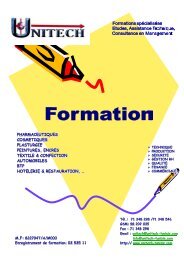Sheen_Catalogue AW.indd
Sheen_Catalogue AW.indd
Sheen_Catalogue AW.indd
Create successful ePaper yourself
Turn your PDF publications into a flip-book with our unique Google optimized e-Paper software.
Appearance<br />
2.0<br />
GloSS<br />
General<br />
Gloss is an important attribute of surface appearance,<br />
it changes our perception of colours and shapes and<br />
influences our overall visual experience.<br />
Gloss affects objects by the interaction of incident light with<br />
the surface and observer and depends on variables such as<br />
illumination angle, surface profile, physical characteristics<br />
and observation conditions.<br />
for many products, gloss can play an important part in<br />
their visual acceptability and for quality purposes should be<br />
monitored with precision instrumentation particularly when it<br />
varies through the process.<br />
Gloss measurement<br />
unified methods for the measurement of gloss are described<br />
in aSTM, din and iSo standards.<br />
When a defined light source illuminates a surface, it is partly<br />
scattered and partly reflected in the equal but opposite<br />
angle. This specular reflection determines the surfaces gloss<br />
level. The intensity of the specular reflection, which depends<br />
on the material and the illumination angle, is measured under<br />
specified conditions. results are expressed in Gloss units<br />
(Gu), which is a calibrated scaling based on the refractive<br />
index of a black glass having a specular reflectance of 100<br />
Gloss units (Gu) at the specified angle. all non-metallic<br />
materials e.g. paints or plastics can have a value related to<br />
this level, while for highly reflective metallic surfaces e.g.<br />
plated components and some raw materials can reach 2000<br />
Gu (mirror gloss).<br />
Multi purpose geometries Gloss differentiation<br />
Table A<br />
Glossmeters<br />
our range of instruments offer a variety of measurement<br />
geometries each applicable to different gloss measurement<br />
applications or materials.<br />
Generally three geometries cover the majority of industrial<br />
applications:<br />
- 20° for high gloss surfaces<br />
- 60° for medium gloss surfaces<br />
- 85° for low gloss or matt surfaces<br />
The 60° geometry is widely used due to its medium gloss<br />
coverage. However, it has been experimentally shown that<br />
when readings taken at 60° exceed 70 Gu, then a change<br />
to 20° is recommended for better differentiation. equally<br />
when readings drop below 10 Gu the geometry should be<br />
changed to 85° for the same reason.<br />
for some specific industrial applications such as the<br />
measurement of ceramics, plastics and paper, special 45° or<br />
75° geometries are also available.<br />
all <strong>Sheen</strong> glossmeters include certified calibration<br />
standards, traceable to BaM, the German national<br />
Standards authority for gloss measurement.<br />
Gloss instruments selection chart<br />
Geometry 20° 60° 85° 45° 75°<br />
High gloss Medium gloss low gloss Medium gloss low gloss<br />
application<br />
aSTM C346<br />
General purposes<br />
Ceramic<br />
foil<br />
paper<br />
Vinyl<br />
aSTM C584<br />
aSTM d523<br />
aSTM d2457<br />
aS 1580 (602.2)<br />
BS 3900 d5<br />
din 67530<br />
din en iSo 2813<br />
JiS Z 8741<br />
MfT 30064<br />
Tappi T480<br />
en iSo 7668 (mirror)*<br />
* Suitable also for mirror gloss, please check instrument & version specific working ranges<br />
10



